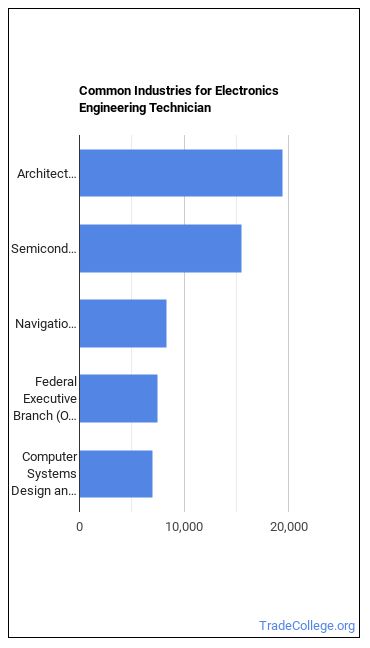All About Electronics Engineering Technicians
Position Description Lay out, build, test, troubleshoot, repair, and modify developmental and production electronic components, parts, equipment, and systems, such as computer equipment, missile control instrumentation, electron tubes, test equipment, and machine tool numerical controls, applying principles and theories of electronics, electrical circuitry, engineering mathematics, electronic and electrical testing, and physics. Usually work under direction of engineering staff.
Electronics Engineering Technician Responsibilities
- Provide user applications or engineering support or recommendations for new or existing equipment with regard to installation, upgrades, or enhancements.
- Write reports or record data on testing techniques, laboratory equipment, or specifications to assist engineers.
- Provide customer support and education, working with users to identify needs, determine sources of problems, or to provide information on product use.
- Adjust or replace defective or improperly functioning circuitry or electronics components, using hand tools or soldering iron.
- Assemble, test, or maintain circuitry or electronic components, according to engineering instructions, technical manuals, or knowledge of electronics, using hand or power tools.
- Maintain system logs or manuals to document testing or operation of equipment.
Featured schools near , edit
Things an Electronics Engineering Technician Should Know How to Do
Electronics Engineering Technicians state the following job skills are important in their day-to-day work.
Reading Comprehension: Understanding written sentences and paragraphs in work related documents.
Critical Thinking: Using logic and reasoning to identify the strengths and weaknesses of alternative solutions, conclusions or approaches to problems.
Complex Problem Solving: Identifying complex problems and reviewing related information to develop and evaluate options and implement solutions.
Active Listening: Giving full attention to what other people are saying, taking time to understand the points being made, asking questions as appropriate, and not interrupting at inappropriate times.
Speaking: Talking to others to convey information effectively.
Monitoring: Monitoring/Assessing performance of yourself, other individuals, or organizations to make improvements or take corrective action.
Types of Electronics Engineering Technician
- Drafting Technician
- Semiconductor Development Technician
- Calibration and Instrumentation Technician
- Instrumentation Technician
- Electronic Systems Technician (EST)
Job Demand for Electronics Engineering Technicians
In 2016, there was an estimated number of 137,000 jobs in the United States for Electronics Engineering Technician. New jobs are being produced at a rate of 2% which is below the national average. The Bureau of Labor Statistics predicts 2,800 new jobs for Electronics Engineering Technician by 2026. The BLS estimates 12,000 yearly job openings in this field.

The states with the most job growth for Electronics Engineering Technician are Nevada, Utah, and Wisconsin. Watch out if you plan on working in Vermont, Kentucky, or Ohio. These states have the worst job growth for this type of profession.
Salary for an Electronics Engineering Technician
The typical yearly salary for Electronics Engineering Technicians is somewhere between $38,110 and $95,140.

Electronics Engineering Technicians who work in Alaska, District of Columbia, or Vermont, make the highest salaries.
How much do Electronics Engineering Technicians make in different U.S. states?
| State | Annual Mean Salary |
|---|---|
| Alabama | $61,120 |
| Alaska | $82,770 |
| Arizona | $63,550 |
| Arkansas | $60,950 |
| California | $67,700 |
| Colorado | $71,860 |
| Connecticut | $65,630 |
| Delaware | $56,680 |
| District of Columbia | $83,330 |
| Florida | $58,500 |
| Georgia | $66,210 |
| Hawaii | $72,390 |
| Idaho | $57,290 |
| Illinois | $67,390 |
| Indiana | $62,730 |
| Iowa | $64,000 |
| Kansas | $65,270 |
| Kentucky | $61,880 |
| Louisiana | $54,980 |
| Maine | $63,380 |
| Maryland | $72,810 |
| Massachusetts | $66,350 |
| Michigan | $59,040 |
| Minnesota | $61,320 |
| Mississippi | $64,070 |
| Missouri | $60,650 |
| Montana | $67,370 |
| Nebraska | $59,220 |
| Nevada | $68,920 |
| New Hampshire | $59,160 |
| New Jersey | $68,740 |
| New Mexico | $64,650 |
| New York | $65,310 |
| North Carolina | $61,080 |
| North Dakota | $67,860 |
| Ohio | $61,040 |
| Oklahoma | $68,500 |
| Oregon | $64,220 |
| Pennsylvania | $56,240 |
| Rhode Island | $69,760 |
| South Carolina | $60,670 |
| South Dakota | $54,190 |
| Tennessee | $56,480 |
| Texas | $67,870 |
| Utah | $60,490 |
| Vermont | $83,540 |
| Virginia | $70,750 |
| Washington | $72,820 |
| West Virginia | $67,960 |
| Wisconsin | $54,290 |
| Wyoming | $74,500 |
What Tools do Electronics Engineering Technicians Use?
Below is a list of the types of tools and technologies that Electronics Engineering Technicians may use on a daily basis:
- Microsoft Excel
- Microsoft Word
- Microsoft Office
- Microsoft PowerPoint
- Microsoft Access
- SAP
- Autodesk AutoCAD
- Spreadsheet software
- Adobe Systems Adobe Acrobat
- Database software
- The MathWorks MATLAB
- Linux
- Microsoft Visual Basic
- FileMaker Pro
- National Instruments LabVIEW
- C
- Supervisory control and data acquisition SCADA software
- Microsoft Internet Explorer
- Dassault Systemes SOLIDWORKS
- Graphics software
How do I Become an Electronics Engineering Technician?
What kind of Electronics Engineering Technician requirements are there?

How many years of work experience do I need?

Who Employs Electronics Engineering Technicians?

Electronics Engineering Technicians work in the following industries:

You May Also Be Interested In…
Those who work as an Electronics Engineering Technician sometimes switch careers to one of these choices:
References:
Image Credit:
More about our data sources and methodologies.
Featured Schools
 Request Info
Request Info
|
Southern New Hampshire University You have goals. Southern New Hampshire University can help you get there. Whether you need a bachelor's degree to get into a career or want a master's degree to move up in your current career, SNHU has an online program for you. Find your degree from over 200 online programs. Learn More > |
